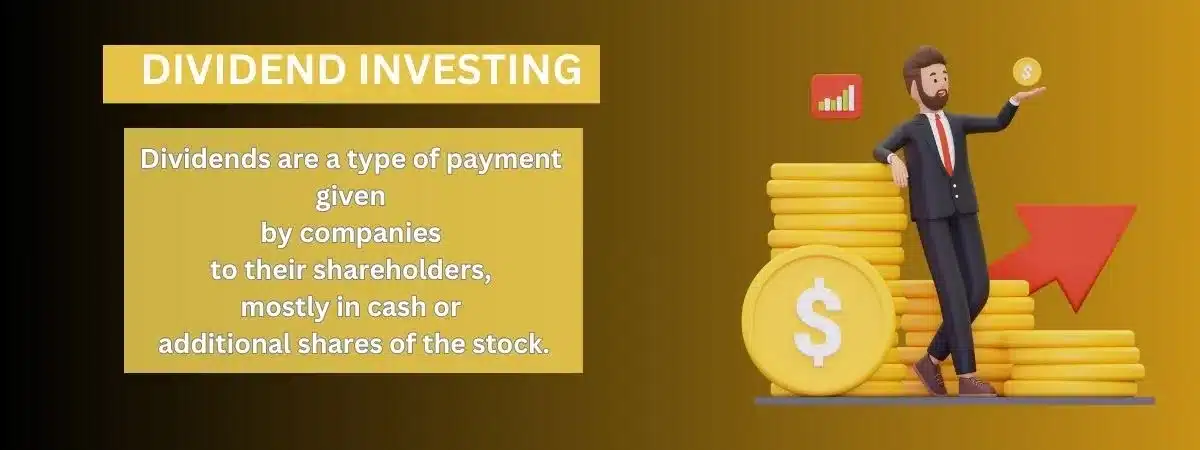When it comes to growing your wealth steadily over time, dividend investing is a strategy worth considering.
This straightforward approach to investing revolves around companies that share their profits with shareholders in the form of dividends.
What are dividends with Example?
Dividends are a type of payment given by companies to their shareholders, mostly in cash or additional shares of the stock.

it represents a portion of the company’s profits that is distributed to the owners (shareholders) as a return on their investment.
Companies that regularly make profits may choose to share those profits with their shareholders in the form of dividends.
Here’s an example to understand how dividends work:
Example: XYZ Corporation
Let’s say you are an investor who owns 100 shares of XYZ Corporation, and XYZ decides to declare a dividend of $0.50 per share.
Number of Shares Owned: 100
Dividend per Share: $0.50
Your total dividend income would be calculated by multiplying the number of shares you own by the dividend per share:
Total Dividend Income = Number of Shares × Dividend per Share
Total Dividend Income = 100 *$0.50 = $50
In this example, you would receive a total of $50 in dividends from XYZ Corporation. You can then choose to either cash out and receive the $50 in cash or reinvest it by purchasing more shares of XYZ Corporation.
Reinvesting dividends is a common strategy that allows you to take advantage of compounding, as you earn dividends on your existing shares and any additional shares you acquire through reinvestment.
It’s important to note that not all companies pay dividends, and the decision to do so depends on various factors, including the company’s financial health, growth prospects, and management’s decisions.
Additionally, the amount and frequency of dividend payments can vary from company to company.
Investors often consider dividends as a source of income and a key factor in their investment decisions.
Understanding Dividend Investing:
Dividend investing is like having your money work for you while you sleep. Instead of solely relying on stock price appreciation, you earn a share of a company’s profits regularly.
These payouts, known as dividends, can provide a steady income stream and contribute to the overall growth of your investment portfolio.
Basic terminology with dividends investing
Dividend:
A payment made by a company to its shareholders, usually in the form of cash or additional shares of stock, representing a share of the company’s profits.
Example: If a company pays an annual dividend of $1 per share and you own 100 shares, you would receive $100 in dividend income.
Dividend Yield:
A financial ratio that shows the annual dividend income as a percentage of the current market price per share.
Formula: Dividend Yield =(Annual Dividend per Share/ Market Price per Share)×100%
Record Date:
The record date is the date by which an investor must be present on the company’s books as a shareholder to receive the upcoming declared dividend. Shareholders on record on this date are eligible for the dividend.
Ex-Dividend Date:
Stock investors who buy the stock on or after the Ex-Divident date are not entitled to receive the upcoming dividend payment.
To get the dividend an investor must buy the share before the ex-dividend date.
“The ex-date and the record date for all the corporate actions are on the same day since all the instruments are moved to the T+1 settlement cycle.” source.
Did you know? The Ex-date and Record date may differ sometimes when there’s a trading holiday after the ex-date.
Click to Check the record date/ex-date for upcoming dividends.
Dividend Reinvestment Plan (DRIP):
A program that allows shareholders to automatically reinvest their cash dividends by purchasing additional shares of the company’s stock.
Payout Ratio:
The part of the company’s profit paid out as dividends to shareholders is called the payout ratio. It is calculated by dividing the total dividends by the company’s net income.
Formula: Payout Ratio=(Dividends/Net Income)×100%
Dividend Aristocrats:
Companies with a history of paying dividends consistently and increasing their dividends regularly for a certain number of consecutive years. These companies are often seen as reliable and stable in their business.
Dividend Declaration Date:
The date on which a company’s board of directors announces the upcoming dividend payment and the amount to be paid.
Dividend Exclusion:
A portion of dividends may be excluded from taxable income, providing potential tax advantages for investors.
Special Dividend:
An extra dividend payment that is not part of the company’s regular dividend schedule. It is often a one-time payment and is typically larger than regular dividends.
Why Choose Dividend Investing?
Stability in Volatile Markets:
Dividend-paying stocks often belong to well-established companies with a track record of stability.
These companies are more likely to weather economic downturns, making dividend investing a resilient choice, even in volatile markets.
Compound Growth:
With the help of compounding you can increase your overall return by reinvesting dividends.
As you reinvest your earnings, you purchase more shares, leading to increased dividends in the future. Over time, this compounding effect will multifold your initial investment.
Regular Income:
Unlike relying solely on capital gains, dividends provide a regular income stream.
This is beneficial, especially for retirees or those investors looking for a reliable source of consistent passive income.
Risks associated with dividend investing
While dividend investing can offer attractive benefits, it is not without risks. Here are some common risks associated with dividend investing that investors should be aware of:
Market Risk:
Fluctuations in stock prices due to market conditions, economic factors, or geopolitical events can impact the value of dividend-paying stocks.
Changes in market sentiment can influence the performance of these stocks.
Dividend Cuts or Suspensions:
Companies may reduce or eliminate dividend payments, impacting investors who rely on dividends for income.
Financial difficulties, declining profits, or strategic decisions can lead to these cuts or suspensions.
Industry and Sector Risks:
Concentrated exposure to a specific industry or sector increases vulnerability to challenges specific to that sector.
Economic downturns or industry-specific issues can affect the performance of dividend stocks in that category.
Payout Ratio Concerns:
A high dividend payout ratio may signal that a company is distributing more cash than it can sustainably generate.
This raises the risk of potential dividend cuts in the future, affecting the reliability of income for investors.
Inflation Risk:
If dividend income does not keep pace with inflation, the real value of the income declines over time.
Failing to account for inflation can erode purchasing power and impact the ability of dividends to meet future expenses.
Getting Started with Dividend Investing:
Research Dividend-Paying Stocks:
The very first step is to find those companies that have a history of consistent dividend payments.
Look for a balance between a solid dividend yield and the company’s financial health.
Diversify Your Portfolio:
Invest your capital in different different sectors to minimize your investment risk.
A diversified portfolio can help protect your wealth during industry-specific downturns.
Reinvest Dividends:
Take advantage of compound growth by reinvesting your dividends. Many brokerage platforms offer automatic reinvestment plans, making the process seamless.
Stay Informed:
Keep an eye on your investments and stay informed about the companies you’ve invested in.
Timely review your portfolio to make sure it is performing as per your financial goals.
India: Taxation on Dividend Income
Dividend Distribution Tax (DDT):
Historically, companies in India were subject to a Dividend Distribution Tax (DDT) on the dividends they distributed.
This meant that the dividends received by shareholders were tax-free in their hands. From 2020 DDT tax has been abolished.
Shift to Classical System:
India moved to a classical system where dividends are taxed in the hands of the shareholders rather than at the company level. source.
Taxation for Individuals:
Dividends received by individual shareholders are now treated as a part of their total income and are subject to tax at their applicable income tax slab rates.
Dividend Distribution on Mutual Funds:
Dividends distributed by mutual funds are also subject to tax. However, the mutual fund company deducts Dividend Distribution Tax (DDT) before distributing the dividends to unit-holders.
Tax Deducted at Source (TDS):
Companies paying dividends are required to deduct Tax Deducted at Source (TDS) at the rate of 10% if the dividend amount exceeds INR 5,000 in a financial year.
Advance Tax:
Shareholders receiving substantial dividends may need to pay advance tax in installments during the financial year.
Conclusion:
Dividend investing offers a straightforward yet powerful way to build wealth over the long term.
By selecting stable companies with a history of consistent payouts, diversifying your portfolio, and reinvesting dividends, you can create a reliable income stream and watch your wealth grow.
Whether you’re a seasoned investor or just starting, consider incorporating dividend investing into your strategy for a more robust and resilient financial future.
FAQs: Dividends Investing
Q: Are dividends a good investment?
A: Yes, dividends can be a smart investment strategy. They provide a steady income stream and offer a way to generate returns even in volatile markets. Companies that consistently pay dividends often demonstrate financial stability and a commitment to shareholder value.
Q: How can I make $1,000 a month in dividends?
A: To achieve a specific monthly dividend income goal, consider the following steps:
- Choose High-Yield Stocks: Focus on stocks with higher dividend yields.
- Diversify Your Portfolio: Spread your investments across various sectors.
- Reinvest Dividends: Leverage the power of compounding by reinvesting your earnings.
- Regularly Invest: Consistently invest in dividend-paying stocks over time.

